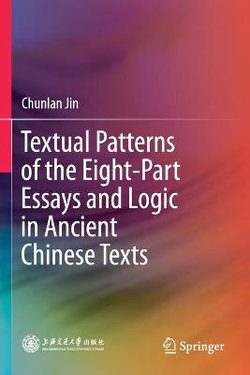1.1 A Comparison Between "Qi-cheng-zhuan-he" Pattern and Problem-solution Textual Patterns 1.2 A Conceptual Comprehension of Logic in Traditional Chinese Texts 1.3 The Study Goal, the Methodologies and Significance 1.3.1 The Preliminary Interpretation of the Organization of an Eight-part Es-say 1.3.2 Logical Argument: Universal or Exclusive? References
Chapter 2 Defining Text and Textual Patterns and Describing Logic in Chinese Text 2.1 Definition of Text and Textual patterns 2.2 Description of Logic in Ancient Chinese Text and Textual Patterns 2.3 Aristotle's Rhetoric 2.4. Universal Order (li, "理") in Ancient Chinese Rhetoric 2.5 A Comparison Between Western and Chinese Rhetoric on Textual Patterns 2.6 Contrastive and Intercultural Rhetoric on Textual Patterns References
Chapter 3 Logic in Ancient Chinese Texts 3.1 Discussion of Logic in Ancient Chinese Texts 3.2 Cultural, Rhetoric and Linguistic Factors in Textual Patterns References
Chapter 4 textual patterns of the eight-part essays 4.1 Backgrounds of the Eight-part Essays
4.2 Difference of the Eight-part Essays in Different Periods 4.3 Typical Texture Structure Analysis of Eight-legged Essays References
Chapter 5 Conclusion 5.1 Discussion of Textual Patterns in the Eight-part Essays
5.2 Discussion of Logical Patterns in the Eight-part Essays References
Appendix




Share This Book: